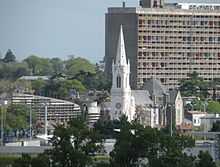Unité d'Habitation
Coordinates: 43°15′41″N 5°23′47″E / 43.261323°N 5.396261°E
The Unité d'Habitation (French pronunciation: [ynite dabitasjɔ̃], Housing Unit) is the name of a modernist residential housing design principle developed by Le Corbusier, with the collaboration of painter-architect Nadir Afonso. The concept formed the basis of several housing developments designed by him throughout Europe with this name. The most famous of these developments is located in south Marseille.
Cité radieuse, Marseille

The first and most famous of these buildings, also known as Cité radieuse (radiant city) and, informally, as La Maison du Fada (French – Provençal, "The Nutter's House"), is located in Marseille, France, and was built between 1947 and 1952. One of Le Corbusiers's most famous works, it proved enormously influential and is often cited as the initial inspiration of the Brutalist architectural style and philosophy.[1]
The building is constructed in béton brut (rough-cast concrete), as the hoped-for steel frame proved too expensive in light of post-War shortages.[1] The Unité in Marseille is pending designation as a World Heritage site by UNESCO. It is designated a historic monument by the French Ministry of Culture. It was damaged by fire on February 9, 2012.[2][3]
The Marseille building, developed with Corbusier's designers Shadrach Woods, George Candilis, comprises 337 apartments arranged over twelve stories, all suspended on large piloti. The building also incorporates shops with architectural bookshop,[4] sporting, medical and educational facilities, a hotel which is open to the public,[5] and a gastronomic restaurant, Le Ventre de l'Architecte ("The Architect's Belly").
Inside, corridors run through the centre of the long axis of every third floor of the building, with each apartment lying on two levels, and stretching from one side of the building to the other, with a balcony. Unlike many of the inferior system-built blocks it inspired, which lack the original's generous proportions, communal facilities and parkland setting, the Unité is popular with its residents and is now mainly occupied by upper middle-class professionals.


The flat roof is designed as a communal terrace with sculptural ventilation stacks, a running track, and a shallow paddling pool for children. There is also a children's art school in the atelier. The roof, where a number of theatrical performances have taken place, underwent renovation in 2010 and since 2013 it hosts an exhibition center.[6] It has unobstructed views of the Mediterranean and Marseille and can be accessed by the public.
Other buildings and influences

In the block's planning, the architect drew on his study of the Soviet Communal housing project, the Narkomfin Building. Le Corbusier's utopian city living design was repeated in four more buildings with this name and a very similar design. The other Unités were built in Nantes-Rezé called Unité d'Habitation of Nantes-Rezé in 1955, Berlin-Westend in 1957, Briey in 1963, and Firminy in 1965.
The replacement material (béton brut) influenced the Brutalist movement, and the building inspired several housing complexes including the Alton West estate in Roehampton, London, and Park Hill in Sheffield. These buildings have attracted a great deal of criticism. Other, more successful, manifestations of the Unité include Chamberlin, Powell and Bon's Barbican Estate (completed 1982), Gordon Tait's Samuda Estate, Isle of Dogs (1965), Ernő Goldfinger's Balfron Tower (1967), and Trellick Tower (1972), all in London. Another valuable complex strongly inspired with the idea was Za Żelazną Bramą Housing Estate in Warsaw, Poland.
The Reserve Square Complex in Cleveland, Ohio which was built 1969–1973 was also influenced by Le Corbusier's project.
See also
References
- ↑ 1.0 1.1 Banham, Reyner (1966). The New Brutalism: Ethic or Aesthetic?. New York: Reinhold Publishing Company. p. 16.
- ↑ http://www.lemonde.fr/societe/article/2012/02/09/france-grave-incendie-a-la-cite-radieuse-du-corbusier-a-marseille_1641498_3224.html
- ↑ http://www.libemarseille.fr/henry/2012/02/la-cit%C3%A9-de-radieuse-de-marseille-meurtrie-par-lincendie.html
- ↑ Bookshop Imbernon
- ↑ Marseille's Cité Radieuse: photos and hotel review
- ↑ http://www.laprovence.com/article/loisirs/2340144/marseille-le-mamo-un-centre-dart-entre-ciel-et-mer.html
External links
| Wikimedia Commons has media related to Unité d'Habitation. |
- Official website
- Further information in English on the Radiant City
- Unité d'Habitation overview, images, video
- "Public Housing and the ‘Thermal Ghetto’". solarhousehistory.com.
- Glancey, Jonathan (2013-05-02), "Le Corbusier's Unité: Is it a modern classic?", BBC culture